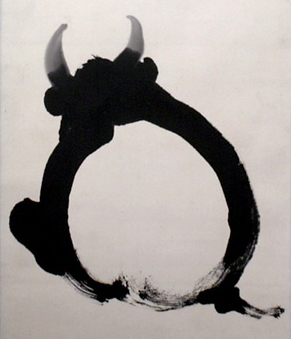| architecture |
| calligraphy |
| ceramics |
| clothing |
| comics |
| gardens |
| lacquerwork |
| literature |
| movies |
| music |
| painting |
| poetry |
| sculpture |
| tea ceremony |
| television |
| theatre |
| weaponry |
| thematic routes |
| timeline |
| the site |
context: painting > Zen painting
Zen painting after 1600

|
a 20th Century Zen bull, by Mokurai |
The new Tokugawa shogunate from 1600 turned away from Buddhism, towards Confucianism, and this meant that the official commissions for Zen artists dried up, and this trickled down to all but end the idea of the professional Zen painter. Monks are painting images as lessons for mostly unsophisticated locals, and also for their own pupils. We get a turn away from the high technical skills of Sesshu, Sesson and the like, towards a much simpler graphic style, more like cartooning, with lots of one-line drawing. This does still take skill - we are talking about ink on paper, and the techniques of handling this are rich and complex - but it does throw a lot away.
And at the end of the Edo period things got worse, as the Meiji Restoration all but banned Buddhism, for instance closing or destroying 18,000 temples from 1872-76. This didn't last too long, but I think there was a nervousness after the antipathy was left behind, and senior Buddhist monks, Zen ones very much included, were mostly very cosy with Japan's rulers as the latter took the country into perhaps the nastiest period in its history during the Twentieth Century.
Lay zen has been a modern attempt to combine Zen with Western philosophising. Given Zen's opposition to logic and categorising and so on, this is a dead loss from either perspective, and has been ignored by Zen monks, but it has proven popular in the West. I find it hard to see this as a good thing, unless we bring in the works of Franz Kline and Robert Motherwell, which we probably will, somewhere along the line.
